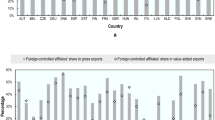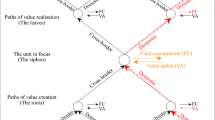Abstract
In the last decade, the concept of ‘global value chain’ (GVC) has become popular to describe the way firms fragment production into different stages that are located in different economies. However, recent evidence indicates that there are lower levels of fragmentation of production. Some authors also suggest that supply chains are regional rather than global. We offer a comprehensive review of the evidence based on the 2018 update of the OECD trade in value added database. The ‘made in the world’ narrative is correct when describing the rise of GVCs in the 2000s. But globalization reached a peak in 2012, and since then supply chains are becoming more domestic rather than more regional.









Similar content being viewed by others
Notes
As was shown by Miller and Blair (2009, p. 33), provided that \( \begin{array}{*{20}c} {a_{ij} \ge 0} \\ \end{array} \) for all i and j and \( \begin{array}{*{20}c} {\mathop \sum \limits_{i = 1}^{n} a_{ij} < 1} \\ \end{array} \) for all j, the Leontief inverse is the solution to an infinite geometric series of \( \varvec{A} \),
\( \varvec{ }\left[ {\varvec{I} - \varvec{A}} \right]^{ - 1} = \varvec{I} + \varvec{A} + \varvec{A}^{2} + \varvec{A}^{3} + \ldots \varvec{ }, \)
which is the analogue to a geometric series in standard algebra: \( \left[ {1 - a} \right]^{ - 1} = 1 + a + a^{2} + a^{3} + \ldots \) for \( \left| a \right| < 1 \). The reason why increasingly higher powers of \( \varvec{A} \) enter the market clearing condition,

is that the suppliers of inputs use inputs themselves, which in turn are produced with yet other inputs all the way back to the initial production stage. In equilibrium, the production of each industry must satisfy both the final demand \( \varvec{f} \) and the intermediate needs of all sectors in the economy \( \varvec{A}\left[ {\varvec{I} - \varvec{A}} \right]^{ - 1} \varvec{f}. \)
Post-multiplication of a matrix by the unit vector \( \varvec{i} \) creates a column vector with elements that are equal to the row sums of the matrix, while pre-multiplication with \( \varvec{i'} \) creates a row vector with elements that are equal to the column sums of the matrix.
The ‘Rest of the World’ is excluded in this calculation, as it is not possible to capture foreign value added for individual countries within this aggregate.
As in Fig. 1, we use a trade-weighted average across countries without the ‘Rest of the World’.
While the minimum value for domestic production stages is 1 (case where no inputs are used in the production process and there is only a single production stage with 100% value added), the minimum value for foreign production stages is zero (when no foreign inputs are used). The maximum index value observed for foreign production stages in the dataset is 2.2 for the production of basic metal products in Viet Nam in 2008 (SNA 1993).
In the same way, we can decomposed the value added by country into nationally clustered and cross-border value added,
\( \begin{aligned} \varvec{V}^{\varvec{C}} & = bdiag\left( \varvec{v} \right) + \left[ {\varvec{I} - \varvec{A}^{\prime}} \right]^{ - 1} \varvec{A}^{\varvec{D}} \varvec{^{\prime} }bdiag\left( \varvec{v} \right) \\ \varvec{ V}^{\varvec{B}} & = \varvec{ }\left[ {\varvec{I} - \varvec{A}^{\prime}} \right]^{ - 1} \varvec{ A}^{\varvec{M}} \varvec{ }bdiag\left( \varvec{v} \right), \\ \end{aligned} \)
where returning value added is recorded on the diagonal blocks of \( \varvec{V}^{\varvec{B}} \).
Mayer and Zignago (2011). http://www.cepii.fr/anglaisgraph/bdd/distances.htm.
The maps are plotted in the Winkel-Tripel projection that makes the spherical circles look a bit distorted, especially when the radius is large.
References
Baines, T. S., Lightfoot, H. W., Benedettini, O., & Kay, J. (2009). The servitization of manufacturing: A review of literature and reflection on future challenges. Journal of Manufacturing Technology Management, 20(5), 547–567. https://doi.org/10.1108/17410380910960984.
Baldwin, R., & Lopez-Gonzalez, J. (2015). Supply-chain trade: A portrait of global patterns and several testable hypotheses. The World Economy, 38(11), 1682–1721. https://doi.org/10.1111/twec.12189.
Bems, R., Johnson, R., & Yi, K.-M. (2010). Demand spillovers and the collapse of trade in the global recession. IMF Economic Review, 58(2), 295–326. https://doi.org/10.1057/imfer.2010.15.
Borchert, I., & Mattoo, A. (2010). The crisis-resilience of services trade. The Service Industries Journal, 30(13), 2115–2136. https://doi.org/10.1080/02642060903289944.
Bown, C. (2018). Trade policy toward supply chains after the Great Recession. IMF Economic Review, 66(3), 602–616. https://doi.org/10.1057/s41308-018-0061-9.
Crowley, M. (Ed.). (2019). Trade war: The clash of economic systems threatening global prosperity. London: CEPR Press.
Duan, Y., Dietzenbacher, E., Jiang, X., Chen, X., & Yang, C. (2018). Why has China’s vertical specialization declined? Economic Systems Research, 30(2), 178–200. https://doi.org/10.1080/09535314.2018.1431610.
Evenett, S. J. (2019). Protectionism, state discrimination and international business since the onset of the Global Financial Crisis. Journal of International Business Policy, 2(1), 9–36. https://doi.org/10.1057/s42214-019-00021-0.
Fally, T. (2012). Production staging: Measurement and facts. Retrieved October 8, 2019, from University of California-Berkeley. https://are.berkeley.edu/~fally/Papers/Fragmentation_US_Aug_2012.pdf
Gereffi, G. (2019). Global value chains and international development policy: Bringing firms, networks and policy-engaged scholarship back in. Journal of International Business Policy, 2(3), 195–210. https://doi.org/10.1057/s42214-019-00028-7.
Gereffi, G., Humphrey, J., Kaplinsky, R., & Sturgeon, T. (2001). Globalisation, value chains and development. IDS Bulletin, 32(3), 1–8.
Hummels, D., Ishii, J., & Yi, K.-M. (2001). The nature and growth of vertical specialization in world trade. Journal of International Economics, 54(1), 75–96. https://doi.org/10.1016/S0022-1996(00)00093-3.
James, H. (2018). Deglobalization: The rise of disembedded unilateralism. Annual Review of Financial Economics, 10, 219–237. https://doi.org/10.1146/annurev-financial-110217-022625.
Johnson, R. (2018). Measuring global value chains. Annual Review of Economics, 10, 207–236. https://doi.org/10.1146/annurev-economics-080217-053600.
Johnson, R., & Noguera, G. (2012). Accounting for intermediates: Production sharing and trade in value added. Journal of International Economics, 86(2), 224–236. https://doi.org/10.1016/j.jinteco.2011.10.003.
Koopman, R., Wang, Z., & Wei, S.-J. (2014). Tracing value-added and double counting in gross exports. American Economic Review, 104(2), 459–494. https://doi.org/10.1257/aer.104.2.459.
Leontief, W. (1936). Quantitative input and output relations in the economic system of the United States. Review of Economics and Statistics, 18(3), 105–125.
Los, B., & Temurshoev, U. (2012, May). Measure of globalization in a world with fragmented production. Paper presented at the 20th international input-output conference, Bratislava
Los, B., Timmer, M., & de Vries, G. (2015). How global are global value chains? A new approach to measure international fragmentation. Journal of Regional Science, 55(1), 66–92. https://doi.org/10.1111/jors.12121.
Mayer, T., & Zignago, S. (2011). Notes on CEPII’s distances measures (GeoDist). CEPII Working Paper 2011–25.
Miller, R., & Blair, P. (2009). Input-output analysis: Foundations and extensions (2nd ed.). Cambridge: Cambridge University Press.
Timmer, M., Erumban, A., Los, B., Stehrer, R., & de Vries, G. (2014). Slicing up global value chains. Journal of Economic Perspectives, 28(2), 99–118. https://doi.org/10.1257/jep.28.2.99.
Author information
Authors and Affiliations
Corresponding author
Additional information
Publisher's Note
Springer Nature remains neutral with regard to jurisdictional claims in published maps and institutional affiliations.
The views expressed in this paper are those of the authors and do not necessarily reflect those of the organizations they work for. This paper is an updated version of Miroudot and Nordström (2015), “Made in the World?”, EUI Working Papers, RSCAS 2015/60.
Rights and permissions
About this article
Cite this article
Miroudot, S., Nordström, H. Made in the World? Global Value Chains in the Midst of Rising Protectionism. Rev Ind Organ 57, 195–222 (2020). https://doi.org/10.1007/s11151-020-09781-z
Published:
Issue Date:
DOI: https://doi.org/10.1007/s11151-020-09781-z





